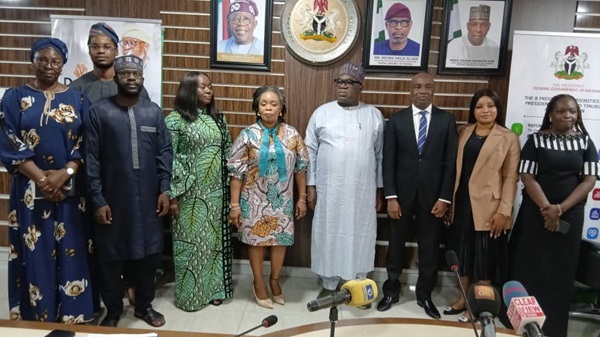
Silas Akpe examines Africa’s unfolding resource revolution, spotlighting the continent’s shift from raw exports to local value‑addition, the push for sustainable development through local content, and the pioneering “Africans for Africa” Fund driving home‑grown industrialisation.
A Continental Call to Action
As the dust settles on the latest preparatory briefings, a striking consensus has emerged from the halls of power in Abuja: Africa can no longer afford to export its wealth in raw form only to import finished goods at a premium. That is the clarion call echoed by Nigeria’s Minister of Solid Minerals Development, Dr Dele Alake and his senior colleagues. Their message is clear—Africa’s abundant minerals, gas, agricultural produce, and renewable energy potential must translate into factories, refineries, and power plants across both urban and rural landscapes.
This is no longer political rhetoric. It marks a deliberate pivot toward tangible value addition – turning unprocessed bauxite into aluminium, lithium into battery components and solar resources into panels manufactured on the continent.
Represented by the director-general of the Mining Cadastre Office, Obadiah Nkom, Alake stressed that the summit’s overarching theme, Harnessing Local Content for Sustainable Development, rejects the outdated paradigm of untapped potential. He insists that local beneficiation is now the default objective, not a distant aspiration. Every ton of ore, he argues, should catalyse downstream industries – generating jobs, tax revenues and technological know-how in the very communities where it is mined. And Africa’s development partners, he added, must contribute not just capital, but also co-ownership, co-management and shared benefits.
This shift in narrative has been years in the making. The inaugural Africa Natural Resources and Energy Investment Summit (AFNIS) in 2022 convened 700 delegates from 20 countries to debate climate-friendly industrialisation and responsible mining. By 2023, conversations will have evolved into policy alignment. And in 2024, the summit launched the “Africans for Africa” initiative—a bold commitment by governments, private sector leaders, and development institutions to mobilise African capital for African industrial ambitions. Underpinning this is a conviction that sustainable development must be built on African agency, not external aid.
Yet the transition from vision to implementation requires more than ambition. It demands rigorous adherence to environmental and humanitarian standards like the SPHERE benchmarks, the Core Humanitarian Standard, and the People in Aid code. Investments must be guided by Results-Based Management methodologies to ensure real, measurable outcomes. Without these safeguards, “value addition” risks becoming another slogan.
Shifting from Dialogue to Delivery
If Dr. Alake’s remarks set the tone, the summit’s structure reflects an uncompromising commitment to results. A closed-door retreat for ministers and CEOs is designed to forge trust and shared vision, while a strategic partnership forum aims to translate declarations into concrete investment memoranda. A technical and investment forum will convene experts in ESG (environmental, social, and governance) criteria, critical minerals and agro-mining integration to drill down into project feasibility and execution.
One of the most anticipated moments is the formal launch of the Africans for Africa Fund, a financial mechanism set to channel diaspora remittances, institutional capital, and domestic savings into industrial projects. With New Frontier Developments appointed as fund manager and Allied Trust Asset Management as operator, the initiative brings both governance and strategic focus. These partnerships underscore that African investors are demanding oversight, structure, and tangible returns, not speculative ventures.
Equally, there’s growing consensus that Africa’s energy transition must be self-financed and self-directed. Delegates will explore how natural gas and renewables can power local manufacturing without exposing communities to volatile costs or locking them into outdated carbon-heavy models. Financing strategies like green bonds and local currency loans are under discussion to shield projects from forex fluctuations and keep them affordable. The underlying principle: Africa’s energy solutions must be created by and for Africans.
Throughout the sessions, capacity building remains a central theme. Attracting multinational firms is not enough; African personnel and agencies must be equipped to lead. The permanent secretary of the Ministry of Solid Minerals Development, Engr. Faruk Yabo, represented by the ministry’s director of mines environmental compliance, Dr. Vivian Okono reminded participants that lasting progress hinges on skills transfer, local empowerment, and institutional resilience. Whether through tailored project management training or hands-on mentoring in environmental compliance, the goal is to enable African actors to own their development processes.
Closing remarks from the director of investment promotion and mineral trade, Dr. Esther Udo drove this point home. The summit, she warned, must not become an annual echo chamber. Its legacy will depend on new ventures launched, local factories built, and tangible improvements in people’s lives. “This summit is a catalyst for change, not a platform for familiar ideas,” she declared.
From Vision to Implementation across the Continent
The momentum in Abuja is not isolated. In South Africa, local content requirements in mining procurement have increased domestic manufacturing output by over 20 percent in just two years. In Ghana, the lithium industrialisation plan – centered around a state-backed refinery co-owned with private investors – is moving from concept to pilot phase, with feasibility studies backed by the African Development Bank. These examples show that the values championed at AFNIS are being mirrored across the continent.
Still, serious hurdles remain. Infrastructure deficits in rail, ports, and energy continue to undermine large-scale industrialisation. Regulatory inconsistencies in some jurisdictions make investors cautious. And the global scramble for critical minerals occasionally puts national strategies in tension with climate commitments.
But the summit’s architects are cautiously optimistic. They believe that with sufficient political resolve, technical capacity, and financial alignment, Africa can overcome these obstacles. Integrated regional cooperation and thoughtful value-chain planning, they argue, are the keys to unlocking transformative growth.
Ultimately, AFNIS 2025 will be judged not by its guest list or soundbites, but by the deals signed and ventures launched. Its success will be measured in new revenue for governments, quality jobs created, and the technologies left behind in local hands. As Africa’s resource custodians have said repeatedly, the continent’s future depends on turning natural wealth into shared, sustainable prosperity – in homes, towns and communities from Lagos to Lusaka.
If previous editions are any guide, AFNIS 2025 could be a turning point. But the real test lies in the weeks and months after the summit, when ideas leave the ballroom and enter boardrooms and policy translates into progress for ordinary Africans. Africa’s resource revolution demands nothing less.
Akpe is a senior correspondent at ‘Science Nigeria,’ with a decade of experience spanning agriculture, climate, and environment sectors in Nigeria and West Africa. He is currently an international development scholar at SOAS University, London.

